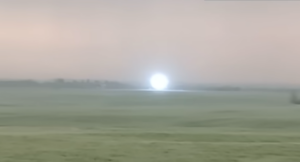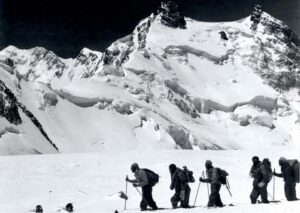On December 4, 1872, a crew sailing for Gibraltar found an unassuming merchant vessel adrift off the coast of the Azores. It was devoid of life.
The Mary Celeste’s cargo and supplies were relatively undisturbed. The former occupants’ belongings were present, the sails were furled, and the lifeboat was gone. With little evidence of chaos, there wasn’t much to go on. The sailors took the Mary Celeste to Gibraltar for further investigation. Soon after, it became the subject of conspiracy theories, rumors, and lies.

The Mary Celeste. Photo: Genealogytrails.com
The Mary Celeste was not an extraordinary ship. It was an average brigantine, refitted from the wreck of its predecessor, the Amazon. After a couple of days of bad weather, the vessel left New York with seven crew members. It was captained by Benjamin Spooner Briggs, an experienced, well-respected sailor. His wife and two-year-old daughter were also on board. They were traveling to Genoa with over 1,700 barrels of denatured alcohol.
Historians assume that all was well until the ship’s final log entry at 5 am on November 25. What took place between then and the Mary Celeste’s discovery by the crew of the Dei Gratia, which was eight days behind them, was a mystery.
They found the ship eerie quiet, with no trace of the crew
The Dei Gratia was heading to Gibraltar when they stumbled across the Mary Celeste. Captain Morehouse sent his first and second mates, Oliver Deveau and John Wright, to the Mary Celeste to check it out. They found the ship eerily quiet. No one was on board and the sails were partially set. But there was some evidence of disturbance. They found disheveled ropes, a couple of open hatches, a broken compass out of place, and a damaged pump.
A six-month supply of food sat untouched, but nine of the alcohol barrels were empty, and some navigational instruments and documents were missing. Some personal items in Briggs’ quarters looked scattered, but there were no signs of a struggle. The floors were wet, and the pair discovered water in the ship’s hold. The lifeboat was nowhere in sight.
Otherwise, the ship was in good enough condition to sail and was by no means sinking. Morehouse ordered some of his crew to sail the Mary Celeste alongside the Dei Gratia to Gibraltar.

A map of the Mary Celeste‘s route. Photo: Google Sites
Was foul play involved?
Before rewarding the crew of the Dei Gratia with salvage payments, Gibraltar’s Attorney General, Frederick Solly-Flood, led an investigation. According to first-hand accounts, he was not open-minded. Once he caught a whiff of the Dei Gratia crew’s eagerness to collect the salvage earnings, he was out for blood.
He immediately suspected foul play and aligned the evidence with his hypotheses. It was not uncommon for ships to be over-insured and then intentionally run aground. After finding red stains on Briggs’ sword and marks from a sharp weapon on the bow, he believed that Captain Morehouse and his crew had stalked the Mary Celeste on the high seas, boarded the ship, and killed Briggs and his party.
Solly-Flood had other theories too. He would not rule out the possibility of a member of Briggs’ crew indulging in the denatured alcohol, killing everyone in a drunken rage, and fleeing in the lifeboat. Solly-Flood even suspected one of the Mary Celeste’s investors, James Winchester, of conspiring to kill the crew. Eventually, a third-party investigation found that the red stains were not blood. Flood gave up his quest and the Dei Gratia crew received a menial £1,700 payout.
Plausible theories
The disappearance of the Mary Celeste’s crew is perhaps the most intriguing nautical mystery. Many believe that a conspiracy took place. The Mary Celeste was over-insured, and many journalists suspected that the crew’s disappearance was no accident. Others believed that the Dei Gratia crew was responsible, as per Flood’s theory. Some theorized that Briggs and Morehouse were good friends who worked together to collect the insurance money. However, there is no evidence of their friendship.
Other theories focus on the ship itself. Perhaps faulty equipment caused the crew to abandon the ship? Maybe the captain overestimated the volume of water in the hold, which turned out to be only 1.1m deep. In these scenarios, the Mary Celeste’s crew would have taken the lifeboat to escape. However, this does not explain the fate of the 10 passengers. The lifeboat was never found.

A waterspout is cited as one possible explanation. Photo: Minerva Studio
A natural phenomenon could be responsible. A powerful waterspout could have swept everyone overboard. It could also explain the water found in the cabins and the hold. Some historians, and even a relative of Briggs, support the idea of an earthquake rocking the ship and causing the denatured alcohol to leak from its barrels, prompting Briggs to abandon ship, fearing an explosion.
Down the rabbit hole
Publishing houses, newspapers, and magazines picked up different versions of the story and devoted column inches to individuals who claimed to be survivors of the ill-fated journey to Genoa. A journal in Edinburgh wrote that a giant sea creature had dragged the passengers into the depths of the Atlantic. Another journal claimed that ravenous sharks had eaten the crew.
Years later, a couple of men came forward, claiming to be survivors of the voyage. The New York Herald Tribune ran a story told by Laurence J. Keating, an Irish writer who claimed that the Dei Gratia crew killed everyone on board the Mary Celeste. Embarrassingly for the paper, this turned out to be false.
Another man, R. Lucy, claimed that the Mary Celeste’s crew abandoned ship when they found a drifting vessel full of silver and gold. Supposedly, they sailed it to Spain where they lived comfortably for the rest of their lives.
Sir Arthur Conan Doyle weighs in
Most notorious was the fictionalized account written by Sir Arthur Conan Doyle for Cornhill Magazine. He never intended for readers to accept his short story as truth. Conan Doyle called it J. Habakuk Jephson’s Statement and wrote it from a survivor’s perspective. In the story, a man goes on a murderous rampage, killing the captain and crew. Jephson survived because he wore a protective amulet. Conan Doyle changed the ship’s name and renamed the crew, but this did not stop readers from believing it word for word.
Modern theories
More recently, researcher Anne MacGregor came to the reasonable conclusion that Captain Briggs may have abandoned the Mary Celeste thinking that the boat was sinking. The disassembled pump may have given him this false belief. Reports from the original logbook (which was conveniently lost in the 1880s) showed that the Mary Celeste was almost 200km away from the position he had calculated them to be. The log also states that he changed course.
MacGregor believes that Briggs changed course to get to the Azores. From there, he would have been able to get his bearings. This theory assumes that Briggs then made the difficult decision to abandon ship because he was unsure of where they were, and if the Mary Celeste was able to sail further.
Finally, UCL professor Andrea Sella simulated an explosion on a Mary Celeste replica. He found that the denatured alcohol (he used butane gas for his experiment) could have been accidentally lit by a crew member’s smoking pipe. This could have caused a ball of fire to shoot up the hatch. The explosion did not cause any visible burning signs. An explosion could have caused chaos and resulted in the evacuation of the ship.
But none of these theories explain the disappearance of the entire crew. Where did they go once they abandoned the ship? Did they drift until they died of starvation? Did they start a new life on an uncharted island? Nearly 150 years later, the fate of the Mary Celeste and her crew is still a mystery.






